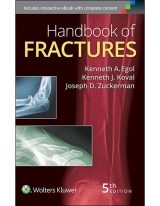I. GENERAL CONSIDERATIONS 1
1 Closed Reduction, Casting, and Traction 3
2 Multiple Trauma 11
3 Open Fractures 25
4 Gunshot Wounds 35
5 Pathologic Fractures 39
6 Periprosthetic Fractures 47
7 Orthopaedic Analgesia 59
II. AXIAL SKELETON FRACTURES 73
8 General Spine 75
9 Cervical Spine 90
10 Thoracolumbar Spine 115
III. UPPER EXTREMITY FRACTURES AND DISLOCATIONS 133
11 Clavicle Fractures 135
12 Acromioclavicular and Sternoclavicular Joint Injuries 142
13 Scapula Fractures 154
14 Glenohumeral Dislocation 164
15 Proximal Humerus Fractures 184
16 Humeral Shaft Fractures 195
17 Distal Humerus 207
18 Elbow Dislocation 225
19 Olecranon 239
20 Radial Head 246
21 Radius and Ulna Shaft 254
22 Distal Radius 266
23 Wrist 279
24 Hand 303
IV. LOWER EXTREMITY FRACTURES AND DISLOCATIONS 321
25 Pelvis 323
26 Acetabulum 339
27 Hip Dislocations 355
28 Femoral Head 367
29 Femoral Neck Fractures 371
30 Intertrochanteric Fractures 381
31 Subtrochanteric Fractures 392
32 Femoral Shaft 400
33 Distal Femur 412
34 Knee Dislocation (Femorotibial) 420
35 Patella and Extensor Mechanism Injuries 429
36 Tibial Plateau 445
37 Tibia/Fibula Shaft 454
38 Injuries about the Ankle 465
39 Calcaneus Fractures 495
40 Talus 507
41 Fractures of the Midfoot and Forefoot 518
V. PEDIATRIC FRACTURES AND DISLOCATIONS 547
42 Pediatric Orthopaedic Surgery: General Principles 549
43 Pediatric Shoulder 557
44 Pediatric Elbow 582
45 Pediatric Forearm 627
46 Pediatric Wrist and Hand 642
47 Pediatric Hip 662
48 Pediatric Femoral Shaft 670
49 Pediatric Knee 677
50 Pediatric Tibia and Fibula 706
51 Pediatric Ankle 721
52 Pediatric Foot 730
VI. INTRAOPERATIVE IMAGING 747
53 Intraoperative Patient Positioning and Fluoroscopy for Fracture Surgery: A Suggested Guide to Obtaining the Quality
Images 749
William Rossy


